S. Jacques Stratton's Blog, page 2
September 11, 2020
Abundance: the Intersection of Philosophy and Finance
Like many Americans whose teenage years coincided with the heyday of shopping malls, I gained access to the working world through the greasy portal of a fast food establishment. I won't use the word "restaurant," as it would only misrepresent, in euphemistic terms, what amounted to a tawdry burger shack. For the grand sum of $3.35 an hour, I helped maintain both the operation's culinary components and infrastructure, cleaning tables, sweeping floors, and traipsing trash. In this capacity, mired in sweaty servitude, I experienced the nihilistic frustration that comes from trading hours for dollars. The frustration turned bitter when Christine K., a high school classmate for whom I nurtured a well-advertised crush, feigned ignorance of our acquaintance, disdaining me and my greasy greeting as she arrived for a snack with her status-conscious friends. My teenage spirit, ever hopeful amid hopelessness, found in these travails a silver lining. If I could only save a sizeable chunk of my earnings, I might salvage a thread of dignity from the tattered fabric of my ego. With enough savings--a teenage version of F-U money--I could quit the burger stand, hopefully in a moment of teen triumph that, I fantasized, might endear me to Christine K., if not her stuck-up friends.
For all its unpleasantry, the burger stand did impart to my teenage brain an important life lesson. The frustration of trading hours for dollars prompted me to think critically about spending habits and the chief liability that drained my funds: my '68 T-bird. A prime specimen of the heavy-metal mojo that once characterized American car culture, the beast had an unquenchable thirst for gas an an affinity for the repair shop, traits that an objective cost-benefit analysis identified as busters to a balance sheet. Either I had to ditch the car or work longer hours, a devil's bargain that my teenage heart found most unpleasant. In sum, the burger stand confronted me with one of money's fundamental truths: saving requires sacrifice. Eventually, I quit the burger stand, but I never quit the savings mentality it helped instill.
A long journey separates the development of a savings mentality from financial abundance, but as Rancroft Beachley reminds us in his new book, CA$H CRAFT: The Musings and Meditations of an Income Investor, they represent mutually informing money milestones, or as Mr. Beachley might pen, "flipsides of the same investing coin." (Full disclosure: deluded that my background as an English teacher qualifies me to opine on bookish matters, Rancroft solicited my services as manuscript editor. Plugging his book thus indirectly toots my own horn, and I excerpted the opening paragraphs of this post from the book's foreword.) But just what does "financial abundance" mean? This question and several others guide the curious, enigmatic, and ultimately fascinating meditations that comprise CA$H CRAFT, a book that merges finance and philosophy in an unconventional way. Frankly, neither the investing nor the personal finance categories offer anything like it. I know this not because of my experience with income investing--a topic which Rancroft's manuscript revealed as nuanced beyond my expectation--but because my editing effort required me, I felt, to gain familiarity with titles from the investing and personal finance genres.
A refreshing quality of CA$H CRAFT is the irreverent critique that the author applies to the presumptions of personal finance. He has little tolerance for blogosphere buzzwords, which he regards more as marketing gimmicks than useful ideas. Case in point, the aforementioned financial abundance, an idea that inspires an almost mystical vocabulary in personal finance literature. Beachley's effort to define "abundance" according to specific metrics gives a taste of the explorations that readers will encounter in CA$H CRAFT. I excerpt the following passage (moderately abridged) with permission of the author.
From Meditation 3, "On Financial Abundance," by Rancroft Beachley
A clever vocabulary, promoted by lifestyle coaches and finance gurus, now pervades the internet. Where past generations offered the unpleasant yet effective admonition that riches require hard work and savings, today’s money muses invite their audience to “win the money game” by “shifting frequencies.” If we accept the metaphor their vocabulary promotes, we can believe that wealth, like sunshine, radiates with widespread resplendence; we need only adopt an “abundance mindset” to enjoy it.
If seekers of wealth needed only a proper money mind to achieve their goal, the world would abound in millionaires. Instead, less than 1% of the world’s population controls assets of one million or greater. 95% of the world’s adults, and 75% of U.S. households, never achieve wealth greater than $350,000. In their eagerness to promote the money mind, today’s finance gurus rarely discuss the Pecuniary Paradox: in a world of abundant wealth, there remains a scarcity of wealthy.
The word “abundance” implies a grandeur that affects us emotionally. We imagine money in such quantities that it functions like the air, flowing through our bank accounts the way breath flows through our lungs, independent of conscious effort on our own. As an income investor whose assets produce significant monthly cash flow, I admit the comparison has merit. However, even though my dividends roll in automatically, I remain conscious of my spending, knowing the role budget-mindedness played in enabling me to attain HNW (high net-worth) status.
Yet if the word “abundance” over-reaches in its implications, it nevertheless provides a useful reference, denoting a state of wealth much greater than that suggested by mere “sufficiency.” On the spectrum of retirement lifestyles, it occupies a place well opposite that of “leanFIRE,” the designation of financial freedom in its most basic form, where wealth generates income sufficient for life’s bare necessities —food, shelter, inexpensive hobbies, and perhaps an occasional social indulgence.
The Metrics of Financial Limitation
For the income investor seeking to build a retirement portfolio, financial abundance provides an aspirational guidepost, denoting a lifestyle much more robust than that of the retiree who merely “gets by.” In order to properly orient our aspirations, we should ponder what it means to “get by.” Even for most people whose wealth extends solidly into six-figures, a confident retirement happens late in life and depends upon substantial infusions from social security. The typical monthly retirement income, according to 2017 data, hardly exceeds $2,600. Annualized, this amounts to only $31,200, about double the 2017 Federal Poverty Guidelines for a family of two. In fact, it approximates the income of someone working full-time at sixteen dollars an hour. If any sales associates, customer service reps, or office clerks relish the prospect of a retirement lifestyle based on the income from a $16 per hour full-time job, I invite them to spend a month in a major American metropolis, which will quickly convince them that the average retirement income provides a below average lifestyle. In Southern California, where I live, this amount barely entitles the recipient to survive, let alone thrive. A couple can easily spend 3K per month just on housing and groceries. Home ownership might reduce, but not eliminate, the cost. Property taxes, insurance, upkeep, community association fees and utilities ensure that those without mortgages still face substantial housing-related expenses. Add healthcare, transportation, plus an occasional entertainment or social activity, and the average retirement income quickly loses its luster.
Of course, the world’s pattern of relative wealth translates to relative costs, and the budget that means subsistence in Los Angeles, New York, or San Francisco might provide happy existence in Las Cruces, New River, or San Jacinto. Geographic arbitrage provides a time-honored enhancement to the lifestyles of America’s retirees, allowing them to stretch pensions and social security payments inadequate for high-cost locales. Promoted in recent years as a “lifestyle hack” by early retirement bloggers, the term hints positively about the joys available to ordinary Americans who relocate to Thailand, or an RV, or perhaps a cabin “off the grid,” where federal poverty guidelines presumably don’t apply.
Exhortations conveyed in print lose much of their dramatic effect, particularly if the sentiments so expressed pose a challenge to cherished notions. The investor who quests for leanFIRE, and who finds in these pages a critique of leanFIRE philosophy, will likely raise a shield of counter arguments against Cash Craft ideas of abundance. If, aged thirty to forty, the leanFIRE aficionado already holds the resources—a portfolio, say, of $500,000—necessary to make leanFIRE dreams a reality, then the shield may come burnished with pride. Blessed with good health and the optimism of self-confidence, a person aged thirty-something may well regard $500,000 as “F-U money,” a ticket to a life untainted by the constraints of the cubicle.
The wisdom of hindsight gives me a perspective that I hope the F-U money-minded will pause to consider. Viewed from the Realm of Seven Figures, 500K represents less a ticket to paradise than a fork in the road. On one hand, it opens the door to sustainable (albeit frugal) adventure away from the rat race. On the other hand, for those who remain in the race, it opens the door to more robust cash flow. Choosing the latter path, I doubled my 500K to a million dollars in just under seven years. Along the way, I stopped thinking in terms of F-U money and more in terms of money momentum, a benefit I could gain by embracing the system rather than dismissing it. In time, the sum I initially considered F-U money looked more like false summit, an achievement worthy of note but whose chief value lay in its position as a vista point on the road to higher attainments.
To their credit, many advocates of leanFIRE recognize the opportunity cost inherent in their quest and offer a philosophical perspective to make that cost more palatable. Quitting the cubicle, they contend, doesn’t mean an end to work. Rather, it means an opportunity to work on terms agreeable to oneself.
Case History: F-U Money Mistakes
Debbie and Marlon, a thirty-something couple who maintained a casual association with the investment club, provide a case history for work-optional living. An attorney with a downtown firm, Marlon voiced frustration with eighty-hour weeks and office politics, a frustration that bred resentment when the firm refused to grant him partner status. At that point, the couple unveiled their F-U money—about $450,000 in mutual funds and real estate equity—which they liquidated to fund their escape. After purchasing a used RV, Marlon deployed the remainder of their assets into an income portfolio that produced about $2,000 per month—enough, they figured, to fund years of nomadic RVing. If they needed additional cash, Marlon assumed he could do freelance legal consulting online and Debbie could follow her passion of writing travel articles.
My investment club mentors criticized the plan’s opportunity cost, noting how the combination of the couple’s net worth and Marlon’s six-figure salary needed only a little time to produce powerful synergies. Undeterred, the couple embarked on their plan, and for a while sent club members a glowing correspondence, replete with pictures of famous locales, intriguing landscapes, and acquaintances met on the RV trail. Then, the correspondence ceased, leaving the couple’s status a mystery.
Some years later, entirely by chance, I encountered Marlon at a gas station in West Los Angeles. Though evasive at first, Marlon confided that he and Debbie had split; unable to fund leanFIRE on his share of the net worth pie, he had returned to “the gripes of the grid.” Unfortunately, his time away from the legal grind set him back professionally, and he found himself scrambling to earn half his former income. Since my own portfolio had by that time swelled to nearly a million dollars and produced over $4,000 in monthly cash flow, I remained circumspect about the difference a handful of years made in our finances, lest Marlon see me as an unpleasant reminder of an alternative road.
I have no doubt that for every story like Marlon’s, another awaits telling, one whose protagonist successfully converts F-U money into years of leanFIRE inspiration. From a portfolio perspective, I take issue not with the possibility of leanFIRE success, but rather the opportunity cost that work-optional living can’t sugar-coat. Though exhortations conveyed in print may lose their dramatic flair, I wonder what exhortations Marlon might invoke, if only he could mail a letter to his younger self. With hindsight, the money that he invoked as a middle-finger gesture to the system proved less meaningful than hoped.
The Metrics of Comfort and Affordability
If we want a budget that allows us to do more than “get by,” or that doesn’t force us to employ “lifestyle hacks” to conjure financial freedom from the equivalent of an office clerk’s salary, we must climb further up the wealth pyramid, into regions occupied by the global top 1%, where the minimum requirement for admission entails wealth ten times greater than the median U.S household. An address in the top 1% means more than a nice view of the wealth pyramid. Financial planners recommend a nest egg equivalent to ten times a worker’s final salary at retirement age. Applying this recommendation to the average U.S. household, whose annual income averages roughly $75,000, we find that a 750K nest egg—in theory—represents the gateway to a comfortable retirement. With inputs from social security averaging $1,300 per month, the retiree with $750,000 comes close to absorbing the $56,000 annual cash burn of the typical U.S. household. If he/she has the benefit of a nest egg invested for cash flow, the $56,000 yearly budget comes easily within range: $15,600 from social security, plus $40,400 from investment income, an easily attainable 5.4% yield on a 750K portfolio.
A simple premise underlies the assertion that a budget of $56,000 represents the threshold of a comfortable retirement. This number denotes the annual expenses of a typical American household and, by implication, buys a standard of living most Americans find comfortable. With a $4,660 monthly expenditure, the budget supports a lifestyle three-and-a-half times better than the Federal Poverty Guidelines for a family of two and equates very closely to the monthly take home pay of a worker earning $38 dollars per hour.
Let’s put it bluntly: if your income through passive sources lets you buy what most Americans seek through sweat, debt, and a paycheck-to-paycheck existence, you occupy an admirable place in the wealth pyramid. But, it’s still not financial abundance.
Some investors may express surprise upon learning that a person could amass wealth greater than 99% of the world’s adults and yet still fall short of financial abundance. In part the surprise stems from consumer culture psychology, which conditions people to regard money not as capital but as a ticket to a shopping spree. The materialist mind pictures a million dollars and dreams of pleasures the sum might purchase. Sadly, the materialist mind often learns too late one of wealth’s subtle truths: having the money to purchase an item doesn’t necessarily make that thing affordable. To understand why, we must view affordability not by sticker price, but by the concept of “permanent capital equivalence”—the amount of capital required to purchase an item from dividends alone.
Consider the coffee achiever whose typical weekday morning includes a Starbuck’s latte, a habit that costs $100 per month to satisfy. Though this amount may not seem burdensome—particularly when viewed piecemeal as a $3 daily expense—the cost changes dramatically when displayed in terms of its permanent capital equivalence. The capital required to sustainably generate $100 per month ($1,200 annually), if invested at the 6% yield typical of my portfolio, comes to about 20K. For most people, the ability to perceive a $100 per month coffee habit in terms of its 20K permanent capital equivalence requires a shift in thinking so extreme as to comprise an uncomfortable disruption of world view.
My investment club colleagues found the concept of permanent capital equivalence so intriguing that they made it a recurring topic of conversation. A club member in possession of a new car, garment, watch, or other accessory often came under immediate scrutiny as debate ensued over the true cost of the purchase. These debates provided an unusual perspective, rarely prevalent among the less money-minded, about the esoteric accounting by which savvy income investors understand the world.
Of course, sometimes items of limited utility count as necessities. Unfortunately, in our culture of money-worship, most consumers succumb to messages that cloud the difference between necessity and the merely nice. When people incur debt to purchase limited-utility non-durable items, the hidden costs balloon. The human preference for instant gratification, combined with the pressure to consume, ensures that only a small minority of workers find the patience and discipline necessary to make assets the means by which they afford indulgence. This, as much as anything, explains how in a world of abundant wealth, there remains a scarcity of wealthy.
The Metrics of Financial Abundance
The Pecuniary Paradox suggests a minimum threshold for the attainment of financial abundance. The fact that a small number of people control the majority of the world’s wealth implies that the numbers associated with financial abundance comprise a domain of exclusivity. By definition, any numbers associated with the average—in wealth, income, or expenditure—don’t qualify. Yet wealth exists on a continuum, and the numbers associated with average provide a basis from which we can extrapolate the minimum necessary for abundance.
The number thus derived will seem laughably low to the Wealth Pyramid’s penthouse dwellers, yet still represent an amount so far beyond the reach of most people as to represent a fantasy. If $32,000, two-times the Federal Poverty Guidelines, means “getting by,” and $56,000, a budget 75% greater (and 3.5 times the poverty guideline) means “comfort,” we can reasonably posit that a budget 75% greater still, or 6.1 times the Federal Poverty Guidelines, means financial abundance for a family of two. These proportions suggest an annual budget of roughly $100,000 as a minimum threshold, a number, coincidentally, very close to the $102,000 that a recent Pew Research Center study, cited by CNBC in 2017, lists as the minimum required to qualify a family of two as upper income. If, from investments alone, an investor sustainably generates income to cover a 100K annual budget, he/she has financial abundance.
Critics who disparage this sum should remember that, due to the different tax treatments of investment income vs. earned income, 100K of dividends roughly equates to the take-home proceeds of a $150,00 salary. I venture that most early retirees, during their working years, would have found a $150,000 salary quite satisfactory.
Very few workers, even those lucky enough to enjoy increasingly rare defined benefit pension plans that provide a promise of substantial salary replacement, can realistically anticipate financial abundance on such terms. The six-figure retirement income, if mentioned in personal finance literature, usually appears as an idealized salary replacement for a target audience advised to work until age seventy in order to maximize social security payouts and IRA distributions. Building such a passive income stream in middle age, without the benefit of inheritance, lottery, or other randomly received capital infusion, merits tremendous acclaim. To reference the wisdom of 17thCentury Dutch philosopher Baruch Spinoza, “all things excellent are as difficult as they are rare.” So with financial abundance.
Savvy income investors who retain a robust cash reserve and build a portfolio with core assets yielding an average of 6%-7% range will need roughly 1.5 to 2 million dollars to qualify for this minimum threshold of financial abundance. Those willing to embrace more volatility might supercharge their portfolios with closed-end funds, whose 8%-9%+ yields make the minimum threshold attainable with assets in the 1.4-1.6 million-dollar range. My own portfolio, which tilts toward a more conservative 6% overall yield, achieves financial abundance with roughly two million dollars of assets and net worth equivalence, where “net-worth equivalence” refers to the capital conversion value of a $3,500 per month pension with 2% annual COLA.
Abundance—the Intersection of Philosophy and Finance
Defining financial abundance in specific terms helps untangle the topic from the slick slogans that seem psychologically compelling but offer little in the way of substantive guidance. I recognize, however, that wealth remains a relativistic concept. An attempt to define financial abundance according to specific dollar quantities may invite criticisms of lifestyle bias. In a relative world—assuming one has enough money to provide for basic needs—who can say objectively that happiness exists in some lifestyle circumstances but not others?
An objective inquiry based on references to the wealth pyramid, income levels, and budgets may ultimately matter less to the aspiring retiree than a subjective inquiry about how to best use that most precious of resources—time—which independent wealth, at any level, makes available. Here, where finance intrudes on philosophy, we must acknowledge that even a lifestyle distinguished by its satisfaction of wants has limitations. While the range of human desire extends to infinity, the ability of money to satisfy human desire remains constrained. Some people may want to have a picnic on the moon, and a certain few even possess the resources to do so. However, to indulge the craving on a frequent basis would deplete the wealth of even the wealthiest.
Financial abundance may offer escape from certain aspects of the human condition, but it doesn’t help us escape being human. In Rasselas, Samuel Johnson tells the story of an Abyssinian prince who left his luxurious valley in search of happiness. “I fly from pleasure,” Rasselas tells a sage, “because pleasure has ceased to please.” After many adventures he returns, convinced of the futility of finding happiness within the sphere of human experience. While Rasselas provides a cautionary tale to those who think riches offer a panacea for Earthly troubles, his example also shows that riches confer a key benefit: time freedom. Ironically, Rasselas’ unique position within the range of human circumstance afforded him the rare chance to fully explore the unpleasantry of being human. Financial abundance may not assure the satisfaction of all wants, nor can it assure happiness—yet it does confer that rarest of gifts: complete ownership of one’s time.
--(CA$H CRAFT: The Musings and Meditations of an Income Investor is available on Amazon in both paperback and e-book format.)
April 17, 2020
In Praise of ROUGHING IT by Mark Twain
 Who among us, in a moment of traffic temper or status-quo stress, hasn't just wanted to chuck it all and "light out for the territories?" I ask the question rhetorically, knowing the craving of the American psyche for open roads and uncluttered horizons that promise possibility. Even in today's point-and-click world, where people increasingly prefer screen-mediated reality to actual experience, the allure of the frontier (or at least the little bit that remains) still resonates, as indicated by the popularity of television shows like "Yukon Gold," "Life Below Zero," and that voyeuristic survival thriller, "Naked and Afraid." Even today, though we get our adventure from a screen, we prefer it in a setting of rugged individualism.
Who among us, in a moment of traffic temper or status-quo stress, hasn't just wanted to chuck it all and "light out for the territories?" I ask the question rhetorically, knowing the craving of the American psyche for open roads and uncluttered horizons that promise possibility. Even in today's point-and-click world, where people increasingly prefer screen-mediated reality to actual experience, the allure of the frontier (or at least the little bit that remains) still resonates, as indicated by the popularity of television shows like "Yukon Gold," "Life Below Zero," and that voyeuristic survival thriller, "Naked and Afraid." Even today, though we get our adventure from a screen, we prefer it in a setting of rugged individualism.In 1861 when Mark Twain boarded a stagecoach for the mining country of the Sierra Nevada, the frontier had little patience for dilettante dreamers. As Twain writes, the lawless land attracted "a driving, vigorous restless population. . .not simpering, dainty, kid-gloved weaklings, but stalwart, muscular, dauntless young braves, brimful of push and energy. . .the very pick and choice of the world's glorious ones." Twain sums up the pagan temperament of this population with a loving indictment: "They fairly reveled in gold, whiskey, fights, and fandangos, and were unspeakably happy." Twain found the hopeful epicenter of this energy in Virginia City, where riches flowed from the silver spigot of the Comstock Lode. Roughing It, with its descriptions of a boom town caught in the grips of speculative frenzy, creates the impression that Twain found romance not in the thrill of getting rich (or for that matter, the risk of going bust) but in simply staking a claim. Of course, Twain did hope to get rich, but thankfully for the literary world, he discovered that he had more talent with a pen than a pick-axe. Twain's foray through mining country provided the seed from which sprouted some greatest short stories in American literature.
William Wordsworth, that lyrical sage of the Romantic period, saw literary force in the experience of emotion recollected in tranquility. By the time Twain penned Roughing It, he'd traded frontier adventure for pursuits that, if not exactly tranquil (speaking now of the heartbreaks that beset Twain's personal life), entailed a more settled domestic routine. Residing first in New York State and later in Connecticut, he must have felt light years removed from the frontier and its vigorous vagabonds. One pictures him comfortably passing a New England winter, warmed by the fireplace as snowflakes coat the window pane, drawing on a wellspring of memory to depict the landscape of his Western wanderings. Perhaps channeling Wordsworth, Roughing It verges, at times, on the poetic, as exemplified by Twain's descriptions of Hawaii, for whose shores he departed as correspondent for the Sacramento Union journal after tiring of the Sierra. Having climbed Haleakala to view the sunrise, Twain writes of the magical sight that draws tourists even today:
Presently vagrant white clouds came drifting along, high over the sea and valley; then they came in couples and groups, then in imposing squadrons; gradually joining their forces, they banked themselves together, a thousand feet under us, and totally shut out land and ocean. . .Clear to the horizon, league on league, with shallow creases between, and with haze and other stately piles of wispy architecture lifting themselves aloft out of the common plane. . .there was little conversation, for the impressive scene overawed speech. I felt like the last man, neglected of the judgement, and left pinnacled in mid-Heaven, a forgotten relic of a vanished world. . .while the hush yet brooded, the messengers of the coming resurrection appeared in the east. A growing warmth suffused the horizon, and soon the sun emerged and looked out over the cloud waste, flinging bars of ruddy light across it, staining its folds and billow caps with blushes, purpling the shaded troughs between, and glorifying the massy vapor palaces and cathedrals with a wasteful splendor of all blendings and combinations of rich color.It was the sublimest spectacle I ever witnessed, and I think the memory of it will remain with me always.
In December 1993, atop Haleakala for my own communion with the dawn, I witnessed a similar scene. Somewhere, stashed away in a box of relics, a photo of it yet resides (although, taken with a disposable camera purchased from a supermarket--I had quite a limited budget in those days--it depicts mostly a grainy blur). But perhaps I don't need the photo. In the manner of Wordsworth, filled with the power of emotion recollected in tranquility, I think I remember the moment. And, I realize that I experienced somewhat differently than Twain. The sunrise I recall resembled less the splendor of resurrection than a poached egg atop a bed of mashed potatoes. In confessing this, I no doubt risk a condemnation of both my character and my literary sense. For a Haleakala sunrise to inspire in me only thoughts of food, while a proper writer like Twain perceived its sublime dimensions, surely bodes ill for my travel writing ambitions.
In my defense, I offer the following excuse: our hotel had a nice breakfast buffet, and I blame my fixation on matters more mundane than sublime on my desire to partake of its pleasures before the kitchen stopped service.
Somehow I think Twain, the sage humorist of American literature, would have found that funny.
In Praise of "Roughing It" by Mark Twain
 Who among us, in a moment of traffic temper or status-quo stress, hasn't just wanted to chuck it all and "light out for the territories?" I ask the question rhetorically, knowing the craving of the American psyche for open roads and uncluttered horizons that promise possibility. Even in today's point-and-click world, where people increasingly prefer screen-mediated reality to actual experience, the allure of the frontier (or at least the little bit that remains) still resonates, as indicated by the popularity of television shows like "Yukon Gold," "Life Below Zero," and that voyeuristic survival thriller, "Naked and Afraid." Even today, though we get our adventure from a screen, we prefer it in a setting of rugged individualism.
Who among us, in a moment of traffic temper or status-quo stress, hasn't just wanted to chuck it all and "light out for the territories?" I ask the question rhetorically, knowing the craving of the American psyche for open roads and uncluttered horizons that promise possibility. Even in today's point-and-click world, where people increasingly prefer screen-mediated reality to actual experience, the allure of the frontier (or at least the little bit that remains) still resonates, as indicated by the popularity of television shows like "Yukon Gold," "Life Below Zero," and that voyeuristic survival thriller, "Naked and Afraid." Even today, though we get our adventure from a screen, we prefer it in a setting of rugged individualism.In 1861 when Mark Twain boarded a stagecoach for the mining country of the Sierra Nevada, the frontier had little patience for dilettante dreamers. As Twain writes, the lawless land attracted "a driving, vigorous restless population. . .not simpering, dainty, kid-gloved weaklings, but stalwart, muscular, dauntless young braves, brimful of push and energy. . .the very pick and choice of the world's glorious ones." Twain sums up the pagan temperament of this population with a loving indictment: "They fairly reveled in gold, whiskey, fights, and fandangos, and were unspeakably happy." Twain found the hopeful epicenter of this energy in Virginia City, where riches flowed from the silver spigot of the Comstock Lode. Roughing It, with its descriptions of a boom town caught in the grips of speculative frenzy, creates the impression that Twain found romance not in the thrill of getting rich (or for that matter, the risk of going bust) but in simply staking a claim. Of course, Twain did hope to get rich, but thankfully for the literary world, he discovered that he had more talent with a pen than a pick-axe. Twain's foray through mining country provided the seed from which sprouted some greatest short stories in American literature.
William Wordsworth, that lyrical sage of the Romantic period, saw literary force in the experience of emotion recollected in tranquility. By the time Twain penned Roughing It, he'd traded frontier adventure for pursuits that, if not exactly tranquil (speaking now of the heartbreaks that beset Twain's personal life), entailed a more settled domestic routine. Residing first in New York State and later in Connecticut, he must have felt light years removed from the frontier and its vigorous vagabonds. One pictures him comfortably passing a New England winter, warmed by the fireplace as snowflakes coat the window pane, drawing on a wellspring of memory to depict the landscape of his Western wanderings. Perhaps channeling Wordsworth, Roughing It verges, at times, on the poetic, as exemplified by Twain's descriptions of Hawaii, for whose shores he departed as correspondent for the Sacramento Union journal after tiring of the Sierra. Having climbed Haleakala to view the sunrise, Twain writes of the magical sight that draws tourists even today:
Presently vagrant white clouds came drifting along, high over the sea and valley; then they came in couples and groups, then in imposing squadrons; gradually joining their forces, they banked themselves together, a thousand feet under us, and totally shut out land and ocean. . .Clear to the horizon, league on league, with shallow creases between, and with haze and other stately piles of wispy architecture lifting themselves aloft out of the common plane. . .there was little conversation, for the impressive scene overawed speech. I felt like the last man, neglected of the judgement, and left pinnacled in mid-Heaven, a forgotten relic of a vanished world. . .while the hush yet brooded, the messengers of the coming resurrection appeared in the east. A growing warmth suffused the horizon, and soon the sun emerged and looked out over the cloud waste, flinging bars of ruddy light across it, staining its folds and billow caps with blushes, purpling the shaded troughs between, and glorifying the massy vapor palaces and cathedrals with a wasteful splendor of all blendings and combinations of rich color.It was the sublimest spectacle I ever witnessed, and I think the memory of it will remain with me always.
In December 1993, atop Haleakala for my own communion with the dawn, I witnessed a similar scene. Somewhere, stashed away in a box of relics, a photo of it yet resides (although, taken with a disposable camera purchased from a supermarket--I had quite a limited budget in those days--it depicts mostly a grainy blur). But perhaps I don't need the photo. In the manner of Wordsworth, filled with the power of emotion recollected in tranquility, I think I remember the moment. And, I realize that I experienced somewhat differently than Twain. The sunrise I recall resembled less the splendor of resurrection than a poached egg atop a bed of mashed potatoes. In confessing this, I no doubt risk a condemnation of both my character and my literary sense. For a Haleakala sunrise to inspire in me only thoughts of food, while a proper writer like Twain perceived its sublime dimensions, surely bodes ill for my travel writing ambitions.
In my defense, I offer the following excuse: our hotel had a nice breakfast buffet, and I blame my fixation on matters more mundane than sublime on my desire to partake of its pleasures before the kitchen stopped service.
Somehow I think Twain, the sage humorist of American literature, would have found that funny.
February 5, 2020
Book Blurb: HEART OF A TRAVELER by Ari Marsh
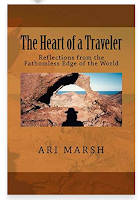 The "Edge," as psychological cliff and geographic boundary, provides a unifying motif for the sketches, vignettes, and poetry that comprise The Heart of a Traveler: Reflections from the Fathomless Edge of the World (PhantaSea Books, 2017), an eclectic travel memoir by California-bred author Ari Marsh. To Marsh, the Edge has an unfathomable quality, for it signifies a transition zone between conventional reality and sublime perception. As a surfer in search of waves and a seeker on a spiritual quest, Marsh takes the reader on a journey through this borderland realm, evoking landscapes that beckon with mystery. We sense the solitude of desert campsites, and shield our eyes when the sunrise sparkles upon the otherworld terrain of Baja California's Crystal Fields. We find an old relic of a surfboard in an isolated Balinese village, and discover that it offers a portal to another era. We juxtapose the sacred waters of the Ganges with the incensed atmosphere of Tibetan temples, and indulge our curiosity about humanity's age-old quest for communion and meaning.
The "Edge," as psychological cliff and geographic boundary, provides a unifying motif for the sketches, vignettes, and poetry that comprise The Heart of a Traveler: Reflections from the Fathomless Edge of the World (PhantaSea Books, 2017), an eclectic travel memoir by California-bred author Ari Marsh. To Marsh, the Edge has an unfathomable quality, for it signifies a transition zone between conventional reality and sublime perception. As a surfer in search of waves and a seeker on a spiritual quest, Marsh takes the reader on a journey through this borderland realm, evoking landscapes that beckon with mystery. We sense the solitude of desert campsites, and shield our eyes when the sunrise sparkles upon the otherworld terrain of Baja California's Crystal Fields. We find an old relic of a surfboard in an isolated Balinese village, and discover that it offers a portal to another era. We juxtapose the sacred waters of the Ganges with the incensed atmosphere of Tibetan temples, and indulge our curiosity about humanity's age-old quest for communion and meaning.Repeatedly, The Heart of a Traveler reminds readers that mystery and intrigue awaits those who probe the world's magical margins, as indicated by the following excerpt:
India continues to stretch my ideas of reality. I've had tea and shared meals with Buddhist monks curious about this Western visitor. We've had engaging conversations about the world, spirituality, and the affairs of nations. I visited the stunning Gyuto Monastery and Tantric University in the nearby mountains, home to the 17th Karmapa. There, I shared rice with senior monks and attended their afternoon puja (fire) ceremony. I also hiked to the base of a huge waterfall outside a small mountain village called Bhagsu Nag and baptized myself in the pure, high altitude waters. . .
On the way back from the falls, I came upon a very old, semi-dilapidated Hindu Shiva temple frequented by a small group of local, rural Hindu villagers. Three sadhus (Indian holy men) with long dreadlocks run the place and live in an adjacent brick cave. I sat and meditated with these guys on the dirt floor of their house-cave for a while. Suddenly, somebody began ringing the temple bell and the sadhus joined in with gongs and drums. I grabbed a pair of large hand cymbals and we were off on a twenty-minute, instrumental, musical jam session followed by chanting. Again, this wasn't a neat, cozy temple with shiny instruments, but a dark cave with incense burning, a small fire cooking an old pot of rice, piles of ragged blankets lying around, and occasional scurrying mice! Yes, these saddhus live in a cave in virtual silence with very little food and almost no possessions. Date and time dissolve amidst this stuff. . . .
Admittedly, Marsh confronts more than mysticism on the travel trail. Returning home, he remains sensitive to the feelings of alienation faced by those whose passion for travel means adopting an unconventional lifestyle. Reflecting on the social values of his American homeland, he recognizes that a culture which links identity to material success will inevitably subject him to suit-and-tie stereotypes judgemental of his wanderlust:
For far too many years, I have followed a different path, responded to a different calling, and sought rhythm and harmony with the sea. but there is a price for a life such as mine. . .the price may be loneliness, on occasion. . .or a lack of stability, or security. . .for mine is a simplicity that many would deem inadequate. We all have choices to make. . .
What have I to show from riding countless thousands of waves. . .for immersing myself in the ocean for literally years of my life. . .for pursuing a dream. . .an intangible connection to nature, to ocean to Source. . .
Like the Tibetan Buddhists who, with great patience and peacefulness, create elaborate mandalas out of colored gains of sand, only to scatter them into nothingness upon completion--an act of symbolizing the impermanent and ever changing nature of our lives--so have I created my own temporary , sacred mandalas upon the smooth blue ocean through dozens of years of riding waves amidst the gleaming Southern California sunlight. Each movement upon the water is a prayer from my heart, a celebration of joy, or a soft cry of suffering amidst this life struggle. . .
Where abides a non-conformist's life, such as mine, upon the spectrum of success, happiness, and achievement?
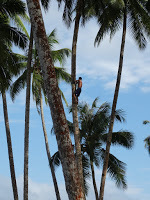 Success, happiness, and achievement. . .in some parts of the world, all that really matters is one's ability to climb for coconuts! Sumatra 2014. . .Photo: S. Jacques Stratton
Success, happiness, and achievement. . .in some parts of the world, all that really matters is one's ability to climb for coconuts! Sumatra 2014. . .Photo: S. Jacques StrattonUltimately, however, Marsh finds that behind the judgement of his peers lies an element of envy:
Several years back, a neighbor was having a party for his son's tenth birthday. I was informed, in advance, that those attending would consist primarily of his son's friends and their parents. "You may not want to come," he had told me, since I was, at the time, both single and childless. It was an interesting period in my life. I had just resigned from a tenured position teaching elementary school and was soon to turn forty. I had recently sold a house that I had once owned with my now ex-wife, and had made a personal vow to "buy my life back." At the party, I began conversing with a guy nearly my age. He told me that he was there with his wife and two children, both of whom were friends with the birthday boy.
A series of questions followed, and thus I, somewhat hesitantly, began to explain my situation. I shared with him that I was not only divorced, but I had just sold my house, quit my job, broken up with a recent girlfriend, and was about to depart on a six-week journey all over California, surfing, hiking, writing, and camping in my truck.
"Wait, let me get this straight," he said in bewilderment, "you don't have any kids, you're not married, and you don't even have a job?. . .Damn, you're so lucky!"
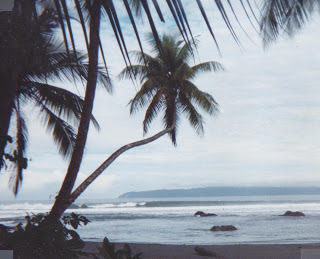 A Postcard from the Edge. . .untrammeled coastlines and meditative reflections await those who embrace the transitional psychology of travel. Pavones, Costa Rica, 1994. Photo: S. Jacques Stratton My own experience with The Edge leads me to conclude that the true benefit of travel occurs in the moments of dislocation that force us to confront our sense of identity. As such, travel represents a transition of the mind as much as movement through geographic space. I lived this transition as an expat, teaching English in Micronesia, an adventure recollected in my travel memoir Islands on the Fringe. I encountered it as a veteran of numerous surf trips, probing untrammeled coastlines where surf perfection channeled meditative reflection. In the manner of good literature, the lyrical meditations that comprise The Heart of a Traveler helped me appreciate these experiences in their spiritual and psychological context.
A Postcard from the Edge. . .untrammeled coastlines and meditative reflections await those who embrace the transitional psychology of travel. Pavones, Costa Rica, 1994. Photo: S. Jacques Stratton My own experience with The Edge leads me to conclude that the true benefit of travel occurs in the moments of dislocation that force us to confront our sense of identity. As such, travel represents a transition of the mind as much as movement through geographic space. I lived this transition as an expat, teaching English in Micronesia, an adventure recollected in my travel memoir Islands on the Fringe. I encountered it as a veteran of numerous surf trips, probing untrammeled coastlines where surf perfection channeled meditative reflection. In the manner of good literature, the lyrical meditations that comprise The Heart of a Traveler helped me appreciate these experiences in their spiritual and psychological context.
January 6, 2020
Three Views of New Zealand: June-July 2010
Righthander #1
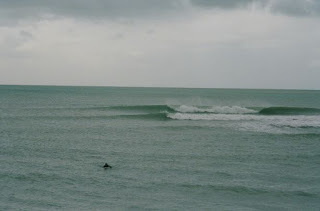 Somewhere south of Gisborne, June 2010. Photo: S. Jacques Stratton
Somewhere south of Gisborne, June 2010. Photo: S. Jacques StrattonIf, due to constraints in time, budget, or social schedule, I had to limit my exploration to one region of this long emerald country, I would choose the stretch of coast centered on Gisborne. The region boasts a marvelous diversity of quality breaks, from points to reefs to beach-break sandbars, and contorts itself with bends and crags that transform one spot's onshore crumblers into offshore peaks at another. I won't state exactly where this wave is--no doubt surf-minded residents of the area will appreciate my sense of discretion--other than to mention that adjacent spots have graced the cover of Surfer's Journal and the nearby environs have a reputation for localism.
On this particular day, late season cyclone swell from the north mingled with wrap-around energy from an Antarctic low, a fortunate combo, as the break acted like it preferred an energetic ocean and would only get better with size. The bigger waves formed as juicy peaks with long walls, great for that style of top-to-bottom surfing characterized by carving turns and off-the-lips. The smaller waves provided great platforms for roundhouse cutbacks, three or four of which could be strung together before the maneuver turned monotonous. I surfed an hour by myself, before two Kiwis, jealous of my solitude, determined I had selected the best reef for the conditions and paddled out to join me, followed a bit later by a smiling Japanese with a longboard. For the next several hours we hooted each other in to set waves and traded surf stories, a motley crew unified by our appreciation of well-formed waves and the thrill of riding them. Periodically I'd look back at the beach road, watching for the arrival of additional cars and the sight of surfers donning neoprene, sure that quality waves must inevitably draw crowds. Yet no one else appeared, and the four of us surfed until hunger and cold turned our attention to matters other than swell, wind, and tide.
Righthander #2
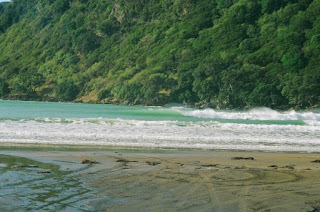 Another roadside attraction, somewhere between Gisborne and Coromandel, June 2010. Photo: S. Jacques Stratton
Another roadside attraction, somewhere between Gisborne and Coromandel, June 2010. Photo: S. Jacques Stratton Drive north from Gisborne toward Coromandel and you MIGHT encounter this phantom wave. I call it a "phantom" to emphasize its whimsical temperament. Highly dependent on swell direction and tide, the enticing peelers witnessed in a moment of sunshine and warmth might turn to grey closeouts in the timeframe required to don a wetsuit and wax a board. Despite this caveat, the beach has a photogenic appeal that makes a visit worthwhile. The water has that turquoise hue that signifies the play of sunlight upon white limestone sediments. Breaking deep within a sheltered, isolated cove, the wave had a furtive, skittish, almost shy personality--as if it needed an offering of food and a sniff of one's hand as a prerequisite to more friendly relations.
Wave #3
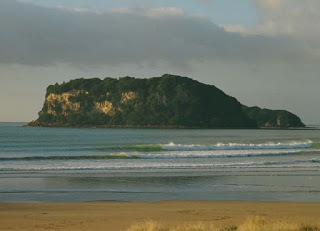 Coromandel corduroy, July 2010. Photo: S. Jacques Stratton
Coromandel corduroy, July 2010. Photo: S. Jacques StrattonTo me, this shot offers a quintessential image of an east coat New Zealand beach scene: caramel sand, picturesque offshore islets, corduroy lines of swell. This spot sits next door to a well-known break that, in the manner of well-known breaks, owes its celebrity status to showy crowd-pleasing performances. Meanwhile, those with a more refined sense of save savvy, and the patience to wait for the proper tide, might hope for this little right-hander to turn on.
I use the word "little" intentionally, because from what I could tell the break couldn't handle much more than about 8' on the face. On this particular day, the swell had come down quite a bit, and was delivering shoulder to head-high grinders along the outside sandbar section.
Once in the lineup, which proved shiftier up close than when viewed from the beach, I settled into position near a greybeard local whose robust wetsuit regalia, replete with gloves and hoodie, made me feel under-prepared. The water isn't that cold, I thought to myself, recovering my trust in my senses. I guess this guy just likes his neoprene. With the deference of travelers to locals, I took a position that let him know he had priority for the next set. When the next set arrived, I waited for him to snag the choice wave. Strangely, he remained passive, uninterested. A feathering lip formed, yet my companion continued his stoic seaward stare. Hating to let the wave go unridden, I quickly spun around, lunged forward with the lip, and raced a sandbar screamer that by most standards ranked as a quality wave. This scenario repeated itself about five more times, until I came to regard the stoic disinterest of the greybeard as a kind of silent rebuke of my enthusiasm. Finally, nonplussed by my companion's apathy to what I considered some dang good surf, I ventured conversation.
"Some fun ones out here, eh?" I prodded, my voice modulated to my excitement.
"If you say so, mate," came the deadpan reply. His eyes, lit with an ethereal glow, seemed to illuminate the underside of his hoodie visor.
"Well, I'm surprised how uncrowded it is. I mean, we're the only guys out, and it's pretty much going off out here. I just caught a smoking down-the-line section!"
"Sometimes it's not about the surf," he explained, his voice slightly contemptuous. "Sometimes it's better to feel the motion of the water, breathe to its rhythm, and appreciate the waves for their beauty alone, rather than what we can do upon them." He fixed his eyes on me to see the impact of his words. "Sometimes it's better just to paddle out and enjoy the scenery," he added.
An English teacher by trade, well versed in the tents of critical thinking, I considered this idea with an open-minded tolerance. Then I thought about the waves I rode, the sweet resistance of water pushing against my inside rail as I dug into a bottom turn, and the weightless suspension of body and board as I smacked an off-the-lip. Better to paddle out and enjoy the scenery? Are you f-----g kidding me? "Well, it's going off out here," I reiterated, as though the statement contained all the logic necessary to refute the greybeard's philosophy.
As another set wave loomed, I returned to the business of riding waves, while my companion returned to their contemplation, and I had a strange sense that as much as I saw the folly in his ways, he saw the folly in mine.
December 10, 2019
Book Blurb: In Praise of THE VOLCANO TRILOGY by Quinn Haber
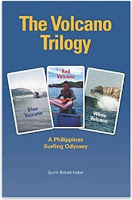 In the manner of a dream, the prospect of living on a tropical island haunts the Western imagination. To the cubicle-confined minions eager to trade corporate angst for balmy breezes, the idea evokes romantic escape. We picture Paul Gauguin in Tahiti (or perhaps even Tom Hanks in Castaway) and think that with a little F-U money, we could ditch the cubicle for sunsets and mai tais. Yet for most people, the dream of Expatica remains just that--a dream, something envisioned but never pursued. For every hundred people that consider it, ten investigate, and of those ten, only one makes good the one-way ticket.
In the manner of a dream, the prospect of living on a tropical island haunts the Western imagination. To the cubicle-confined minions eager to trade corporate angst for balmy breezes, the idea evokes romantic escape. We picture Paul Gauguin in Tahiti (or perhaps even Tom Hanks in Castaway) and think that with a little F-U money, we could ditch the cubicle for sunsets and mai tais. Yet for most people, the dream of Expatica remains just that--a dream, something envisioned but never pursued. For every hundred people that consider it, ten investigate, and of those ten, only one makes good the one-way ticket.The Volcano Trilogy, re-published by Phantasea Books in 2019 as an updated edition with additional photographs and postscript material, recounts how love for an island girl and steadfast commitment to a surf lifestyle enabled the author, Quinn Haber, to transform dream into reality. Notably, Haber pursues his island dream while maintaining a full recognition of the downside to having a third-world address, as described in this excerpt from a chapter titled "A Fresh Coat of Paint:"
Exotic, primeval, unsettling--no word can accurately describe the drive from the main highway to the beach. In pasta-shaped convolutions, the badly deteriorating thoroughfare weaves through an impoverished village deeply ingrained in the surrounding hillside. It's a hidden barrio of impossibly gnarled trees, houses made of scraps of anything, skinny people who seem to hide in their own shadows, and emaciated cattle standing in empty plots of dry dirt. Here along the Philippines back roads, whole generations pass in utter poverty without the rest of the world ever seeing them or knowing they exist. It's this very invisibility I find the most disturbing. I know intellectually that ninety percent of the world's population make less that one U.S. dollar a day, and that poverty is relative by degrees of severity--after all, this is not widespread famine in the horn of Africa, and we do have a fair amount of poverty in the USA--but still, this shockingly visceral drive through the daily plight of the unknown Filipino is an experience I'll never forget. There's absolutely no social welfare here, as far as I can see. To be aware of another's sufferings is to shade what might otherwise be a rosy backdrop in our lives. Shall we simply cover the disturbing images with a fresh coat of paint, letting go of what we have seen, and move on? Driving this road to Sabang reveals the hard struggle of developing nations, a reality most traveling surfers come into contact with at some point, or at many points, along their journeys. As I watch the forlorn hinterlands disappear through the rear window, then turn to see a surfer's bounty of pristine beaches and waves, I feel humbled by the experience.
Of course, confrontations with "otherness" comprise a key motif of travel literature, and few settings highlight otherness more than the poverty-stricken third world village. For Haber, the confrontation evokes a sensitivity that establishes his credentials as a thoughtful commentator. In the above passage, as throughout the book, Haber takes care to place descriptive detail within its social, historical, economic, and cultural context.
As a surf travel memoir, the book places landscape and seascape front and center, but some scenes involve readers in Haber's mental landscape as well. On occasion, the book recalls moments of personal challenge to which the author, in poetic fashion, attributes a metaphorical significance. Haber's recollection of a cliff-dive, and the lesson it presents for his romantic aspirations, stands out as an example:
Fraser takes me on a short but steep climb to the top of the promontory. We walk out over the rocky cranium and look down at the water, some sixty feet below. "Jump" he says--or was that an order? "Really? From here?" "Yeah mate. I do it all the time." "It looks pretty far." "Only fifty feet or so , mate, depending on the tide." "Well, what's the tide now?" "I think it's coming up, mate." "How deep is it?" "Plenty deep, mate. No worries. No worries at all. Just keep ye arms and legs together so they don't get torqued on impact, and cover ye pearls with ye hands." "My pearls?" "That's right, mate. Ye jewels." "Are you going to jump?" "Nah, ya should jump mate! I do it all the time. It's really not as high as it looks." "I'll go if you go first." "That won't work, mate. Who'll carry our shirts, hats, and sunglasses back? Not to mention my wallet?" "You brought your wallet?" "Mate, in the Philippines, ya never know when ya'll need to prove yourself with some identification or a bribe. So are ya going to jump or not, mate? I haven't got all day." I look over the ledge and see a collage of blues delineating various patches of reef at differing water depths. "Are you sure I won't hit bottom?" "Ah, no dramas, mate! It's at least eight meters deep." I hesitate, then slowly pull of my shirt and sunglasses and give them to the man that resembles Clint Eastwood now more than ever. It's as if I'm handing the last of my personal belongings to my executioner. "Okay, Fraser," I mumble, "I guess I'm going." "Only if ya want to, mate. I don't want to pressure ya." But by now, having removed my personal effects, I feel irrevocably committed. I inch towards the ledge and peek over again. There's nothing between me and the water but a great distance of air. I begin to hesitate, but before I let my mind take over, I leap over the edge and feel the wind rushing up all around me. I reach for my 'pearls' and soon am engulfed by the liquid blue. I don't penetrate very deep and the whole thing is over quickly. Fraser was right, it's an easy jump and drama isn't necessary. Going for things should be like this--once you decide to commit, you shouldn't hesitate and psyche yourself out, but just do it and jump! I think that proposing to Janice, if that is ultimately what I decide, will require this same sort of leap.
As revealed in the book's postscript material, the author did end up making the lifestyle leap, though it involved a path more circuitous and fraught with unexpected complications than anyone could have realized. No spoilers here, other than this: the postscript material alone, with its overview of events that take place in years subsequent to those depicted in the narrative, makes the purchase price worthwhile.
As a veteran of four trips to the Philippines, one completed as recently as 2019, I can attest to the accuracy of the book's back-cover synopsis, which touts Haber as a keen-eyed witness, whose "observations of the Philippines far north present a compelling view of Southeast Asian life, encompassing everything from local traditions, to courtship mores, to exquisite country surf and tourist sites." The surf traveler, understandably interested in depictions of the "exquisite country surf," will find the following excerpt a representative sample of the play-by-play accounts:
I pick up the binoculars and study the break again. Star Tubes, a right-hander peeling off the
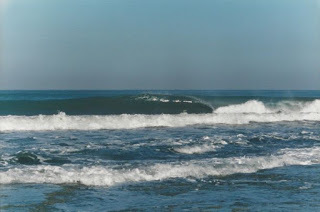 It's a fast and hollow wave. . .Star Tubes, December 2001. Photo: S. Jacques Strattontip of a reef shelf, is not known to handle too much size. It's a fast and hollow wave, and quite shallow. Today it is clearly off the Richter scale, with frequent, big sets thrusting over the shelf, their open faces reflecting the gleam of sunrise one second, then turning dark the next as they hollow out and detonate into the shallows. After each bomb, the sound of the explosion resounds off the lodge walls seconds later, like an eerie aftershock evincing a mere afterthought of the wave's true power. Even from here, a half mile away, Star Tubes looks scary enough. Moments later, I see Fraser walking out across the causeway, heading towards the bay with surfboard in hand. I ponder what the hell to do. . .
It's a fast and hollow wave. . .Star Tubes, December 2001. Photo: S. Jacques Strattontip of a reef shelf, is not known to handle too much size. It's a fast and hollow wave, and quite shallow. Today it is clearly off the Richter scale, with frequent, big sets thrusting over the shelf, their open faces reflecting the gleam of sunrise one second, then turning dark the next as they hollow out and detonate into the shallows. After each bomb, the sound of the explosion resounds off the lodge walls seconds later, like an eerie aftershock evincing a mere afterthought of the wave's true power. Even from here, a half mile away, Star Tubes looks scary enough. Moments later, I see Fraser walking out across the causeway, heading towards the bay with surfboard in hand. I ponder what the hell to do. . .
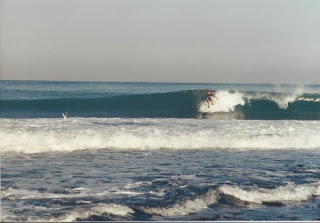 No pondering here. Haber drops in to "Starries," December 2001. Photo: S Jacques Stratton
No pondering here. Haber drops in to "Starries," December 2001. Photo: S Jacques StrattonAccompanied by a cornucopia of photographs, such passages give the reader a front row seat to the action.
As a "genre" the surf travel memoir remains obscure, a curiosity within the broader tradition of travel literature. In part the obscurity stems from social attitudes, prevalent until recently, toward surf culture. For decades dismissed by the mainstream as vagabonds unworthy of serious attention, surfers more frequently supplied stereotypes for film and T.V. (think Jeff Spiccoli from Fast Times at Ridgemont High) than interesting protagonists. For its part, surf culture often encouraged its marginality, maintaining through slang and hatred of outsiders a tribal insularity enigmatic to the mainstream. Knowing this dynamic, publishers regarded book-length surf travel narratives with skepticism, recognizing their extremely limited audience appeal. In recent years this has begun to change. Advertisements for products ranging from cars to beer now promote surfing as an desirable component in an adventure lifestyle, and the conflation of surfing with popular lifestyle fads (witness the profusion of Yoga/Surf retreats) brings surf culture into the mainstream. In tandem with this trend, the surf travel memoir has begun to gain traction as a literary form, with prominent works such as Allan Weisbecker's In Search of Captain Zero setting the bar. For its comprehensive exploration of a region still regarded as a surf frontier, Quinn Haber's Volcano Trilogy deserves honorable mention alongside such works, and I think fans of surf travel memoirs will find it a worthy addition to their bookshelves.
December 9, 2019
Adventures in the Pacific's Backwater Bars: Akane
Though Jane Austen fans will no doubt cringe at my crass adaptation of one of literature's classic opening lines, I find it an apt (if generalized) characterization of the single-and-searching mehnwei men that, on the eve of the millennium, frequented Pohnpei's drinking establishments hoping for a fling. (Lest readers interpret this characterization as a critique, let me state for the record that I include myself among the ranks of those hapless souls, and probably indulged in more embarrassing foolishness than most. You won't get any holier-than-thou moral missives from me.)
At first, love-lorn expats did not apply much selectivity when choosing a target for a passionate plot. Some called it the "rainforest effect"--influenced by the primal nature of our surroundings, we gave in more easily to the primal nature of our libidos. With time, however, even the most wide-ranging libertine succumbed to the gravitational pull of the women affiliated with the JOCV (Japanese Overseas Cooperation Volunteers). To cast these women as Oriental playthings in a Western fantasy overstates their innocence. They knew full well the power of their allure, and for socio-cultural reasons of their own, often made targets of us.
A dozen or so of these ladies made the dim booths of Club Flamingo the center of their weekend nightlife. Located just off the waterfront road, Club Flamingo commanded a view of the harbor and boasted an electric sign, status markers that added to its panache as the largest bar in the FSM. Weekend crowds might overwhelm the parking area, spilling the overflow vehicles onto the road and contributing to the sense that Club Flamingo offered Pohnpei's closest approximation of a cosmopolitan experience.
The following excerpt from Islands on the Fringe recollects an evening that began at Club Flamingo and shows that when pursuing romantic flings with the ladies of the JOCV, the scammer sometimes got scammed: In line for the bar at Club Flamingo, I meet her, the Japanese girl with the jasmine perfume. She wears stiletto heels and a jade pendant that invites a glance toward her neckline. Apart from her nose, of an aquiline variety slightly too large for her face, she exudes a refined beauty, a blend of Western style and Eastern mystique, and from the way a table of elder ex-pats eyes her, I can tell her effect extends through the room. Seeing the empty glass in her hand, I offer to buy her a drink. "Oh, you genterman!" she says, her accent transforming l to r. "From time I first see you, I know you genterman." "Well, I try," I say. "What's your poison?" "Po-san?" "What would you like to drink?" "Oh. I rike Bruddy Mary!" Together, we sidle up to the bar, and wait for the bartender to finish his prior orders. As we wait, we exchange names. She leans toward my ear. "You my kind of man," she whispers. Eventually, I place the order, but get bad news: no Bloody Mary mix. The bartender advises us to visit the Village Hotel, purveyors of the best Bloody Marys on the island, all from fresh ingredients. The recommendation excites Akane, who coyly transforms my drink offer into a dinner date. Though beyond my budget and a bit of a drive, the Village Hotel promises a romantic setting, and I acquiesce, lured by Akane's petite figure and flattering comments. Once at the hotel, I feel more like a charlatan than a gentleman. Our table in the dining area places us alongside the upper-echelons of island visitors: retirees on round-the-world trips, businessmen seeking deals with island moguls, and perhaps a few diplomatic types mingling with representatives from the FSM legislature--in short, people who spend in a day what I earn in a month. Then, remembering the credit card in my wallet, I settle more easily in my chair, order two Bloody Marys, and pretend not to notice when Akane orders the most expensive dish on the menu. "You my kind of man," Akane tells me again, when the waiter departs. "You treat girl right." Her smile, engineered for flattery, could make even the most committed cheapskate abandon his budget. But later, when the dinner arrives, I find Akane strangely changed. Instead of flattery, I now only hear the clink of silverware. The glances that she once reserved for me she now directs only to her plate. And, later that night, after I pay the bill and drive her back to town--a drive which she seems to endure in awkward discomfort--my goodbye kiss meets only a grudgingly presented cheek. A week later, during a gathering at the Australian embassy, I see her by the pool, an empty cocktail glass in hand. She pretends not to recognize me, instead reserving her attention for a dapper young member of the embassy staff. Seeing her empty glass, he offers to get her a drink. "Oh, you genterman!" I hear her tell him. "You my kind of man."
Scrapbook Moment (Sumatra 2014)
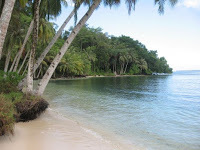 A jungle trek leads to a hidden cove
A jungle trek leads to a hidden cove
Dangled for dramatic effect, the phrase carries overtones of intrigue, suggesting mysterious possibility beyond the constraints of ordinary experience.
Consider the following usage:
"The surf camp patrons, staring despondently at the ankle slappers that lapped the reef outside their bungalows, returned to their hammocks or the distractions of the pool table. Meanwhile, on the other side of the island. . . Here, we wonder if the conditions at the surf camp convey a true picture of that day's surf potential.
With a bit of gumption, a daypack of provisions, and a liberal application of bug repellent, the intrepid surf explorer eager to impersonate Indiana Jones can enter the jungle and, after struggling through suffocating humidity and mud-marred paths, emerge from the shadows to find a place where the constraints of ordinary experience not only diminish but give way to paradise visions. One may find, for example, a deserted cove, untrodden sand edging an emerald sea, where balmy breezes carry an echo of the dreamtime. There, an apparently perfect left spins beyond the lagoon, a fantasy wave, its shoreward surge like the frolic of a winged horse in a meadow of the gods.
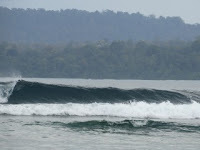 Sumatran secret. . .Photo: S. Jacques Stratton When I first saw the wave it seemed surreal, as though the jungle trek had somehow warped the fabric of space-time and confronted me with a scene from the primordial Earth. Under the sheen of sweat and bug repellent coating my face, I could feel my expression contort into that wide-eyed, open-mouthed variety that signals bewilderment. In part, this expression resulted from my recognition of a perplexing irony: during the run of swell over the prior week, charter yacht crowds battled for waves seemingly half as good. To find a dream wave going off under the radar screen on a day deemed flat by the standard metrics seemed beyond strange. Additionally, the irony had a personal dimension that seemed more cruel with each successive wave that spun down the reef. I didn't have a board. . .
Sumatran secret. . .Photo: S. Jacques Stratton When I first saw the wave it seemed surreal, as though the jungle trek had somehow warped the fabric of space-time and confronted me with a scene from the primordial Earth. Under the sheen of sweat and bug repellent coating my face, I could feel my expression contort into that wide-eyed, open-mouthed variety that signals bewilderment. In part, this expression resulted from my recognition of a perplexing irony: during the run of swell over the prior week, charter yacht crowds battled for waves seemingly half as good. To find a dream wave going off under the radar screen on a day deemed flat by the standard metrics seemed beyond strange. Additionally, the irony had a personal dimension that seemed more cruel with each successive wave that spun down the reef. I didn't have a board. . .
Why would I? Observing the languid waters fronting the surf camp, I, like the other patrons, wrote off the day's surf potential and made other arrangements. When my wife the anthropologist enlisted me on a jungle trek to photograph monkeys, I planned my equipment needs accordingly--
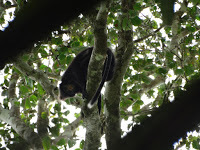 Mystery monkey. . .Photo: S. Jacques Strattondaypack, bottled water, camera accessories, and hiking boots. The idea that I should add my surf gear to the equipment list, on the rare chance that I might stumble across a dream wave in The Land That Time Forgot, simply never occurred to me.
Mystery monkey. . .Photo: S. Jacques Strattondaypack, bottled water, camera accessories, and hiking boots. The idea that I should add my surf gear to the equipment list, on the rare chance that I might stumble across a dream wave in The Land That Time Forgot, simply never occurred to me.Well, that was about to change. . . One nagging detail--a consolation of sorts--kept me from kicking the sand in frustration and calling myself an idiot. Lacking reference points, I had no sense of the wave height. Subjecting the scene to the scrutiny of the camera's zoom lens offered little clarification. I couldn't tell if the ruler-edged peelers that came into focus represented knee-high reef scrapers or double-overhead bombs with board snapping potential. I couldn't tell, but I knew I had to find out. . .
To her credit, Mer recognized the call of the sea in my anxious expression and absolved me of further wildlife photography duties. Though well intended, this selfless gesture only increased my anxiety, causing me to contemplate the sense of foolishness that would no doubt afflict me if, after a sweaty slog back and forth through the jungle, I returned with my surf gear, only to find the vision of fantasy surf shattered by different tide and wind conditions. I'd heard tales of Indonesian reefs that, once in a Blue Moon, turned on as tidal forces pushed water over special coral contours, and I wondered if this spot might fit that profile. My mind a-whirl with such speculations, I set a feverish pace back to the bungalows. In my haste I lost an appreciation for potential trail hazards, one of which, a brown snake whose presence I discerned thanks to my wife's shouted warning, slithered into the bracken as I passed by.
Back at the camp, a profusion of empty beer bottles and the lethargic sprawl of my fellow guests indicated I'd have difficulty generating interest in a formally organized surf expedition, but the close encounter with the snake reminded me of my position on the world's wild edge and the benefit of companions. Specifically, I hoped to drum up a skiff and a surf guide, and thus avoid another jungle trek. Unfortunately, the camp crew had all embarked on errands, and the most interest I could generate in my fellow campers was a bemused "good on ya, mate!" from an Australian, who clearly regarded my report of perfect surf on the other side of the island as the raving of a madman. Recognizing the implication of these disappointments, my wife, again to her credit, agreed to accompany me back to the cove. If my determination to surf alone at an isolated reef ended in tragedy, she could at east give the authorities a proper accounting. (A dedicated rule follower, she often displayed excessive concern for the importance of governmental oversight, and felt certain that some village chief, if not a badge-toting Indonesian official, would consider my venture some sort of trespass and materialize from the jungle to issue a citation.)
Meanwhile, on the other side of the island. . . After another jungle jaunt that depleted a good portion of the calories I needed for surfing, we returned to the hidden cove.
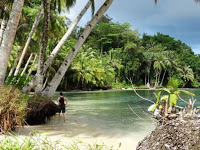 We returned to the hidden cove. . .Photo: S. Jacques Stratton With a cackle of glee I mocked my wife's concerns about governmental oversight. The pace clearly lay within the jurisdiction of pagan powers. The only recognizable banner of authority belonged not to human institutions but to the surf gods, who unfurled another
We returned to the hidden cove. . .Photo: S. Jacques Stratton With a cackle of glee I mocked my wife's concerns about governmental oversight. The pace clearly lay within the jurisdiction of pagan powers. The only recognizable banner of authority belonged not to human institutions but to the surf gods, who unfurled another
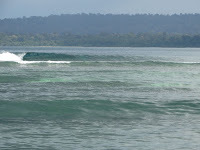 "I'm out there!. . .In truth, I had no sense of the wave height.magical set for my appreciation. "I'm out there!" I intoned, intending to make up through enthusiasm the calories lost during the jungle trek.
"I'm out there!. . .In truth, I had no sense of the wave height.magical set for my appreciation. "I'm out there!" I intoned, intending to make up through enthusiasm the calories lost during the jungle trek.The first part of the paddle-out went easily enough. Between the beach and the fringing reef, a waist-deep lagoon, its clear waters a sanctuary for colorful fish, offered an inviting paddling path. Yet here I encountered a surprise indication that I had indeed stumbled upon the primordial edge, where expected forms acquire unexpected dimension. The lagoon proved wider than I initially judged--much wider. When I finally reached the shallows of the fringing reef and stood on the coral, I looked back to see my wife as a small speck on a distant beach. The surprise width of the lagoon foreshadowed the surprise width of the reef, whose sharp corrugations I now traversed carefully, treading my booties through a minefield of urchins, anemones, fire coral, and other toxic terrors. Eventually, I reached the point where the bubbly aftermath of the oncoming waves surged against my shins, and there discovered another surprise: what from the beach looked like playful splashes of foam resolved, upon closer inspection, into hissing whitewater cauldrons powerful enough to blast me off my feet. "Holy s--t!" I muttered to myself. "It's bigger than I thought."
Rather than pause to reassess the situation, I did what most surfers would do when presented with a lull between sets--I paddled hurriedly seaward and angled my way toward the take-off area. And now, lured fully into the surf zone, I finally understood why I had such difficulty determining wave height from the beach. As a dark shadow formed in the sea off the headland, a great suction of water dredged off the shallows, leaving the reef almost dry. Where shadow and suction met, a lip pitched forward, impacting below sea level just inches from the exposed coral. Invisible from the beach, the full scope of this dynamic did not become clear until witnessed from a waterfront seat.
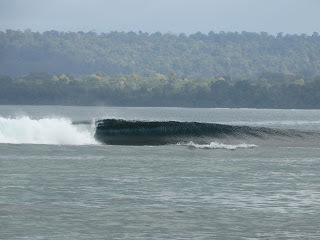 Perfect, or perfectly deadly? That lip is impacting below sea level, inches from exposed coral. Photo: S. Jacques Stratton
Perfect, or perfectly deadly? That lip is impacting below sea level, inches from exposed coral. Photo: S. Jacques StrattonDriven more by a sense of showmanship than a real interest in riding the dredging demons, I waited on the periphery, hoping an amiable shoulder would offer an entry point that didn't entail a vision of my body impaled upon coral heads. That game soon ended when I padded for, backed out of, and nearly got sucked over the falls on a wave I initially judged as head high but which morphed into a 10' face. Deciding to make discretion the better part of valor, I made my way back to the beach. It's out there, if you want it--the jungle path, the hidden cove, the perfect (and perhaps perfectly deadly) wave. You won't know until you go. My advice: bring a helmet, and don't surf alone.
December 7, 2019
Book Blurb: In Praise of Edward Abbey's Desert Solitaire
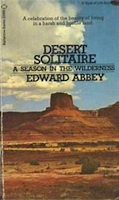
I first read Desert Solitaire as a college student. Bored with my term paper on the thematic concerns of the Victorian poets (memo to Matthew Arnold: it couldn't hurt to do some partying every now and then!), I longed for spring break and the possibility of libertine landscapes. The front cover of Desert Solitaire, with its wild canyonland panorama, caught my eye. Turning the pages, I found myself engrossed in a narrative that appealed to my incipient literary ambitions. Because of course English majors fancy themselves as writers, I thought that I could begin my own career in a fashion similar to Abbey--work for the BLM, live in a cabin, and write about adventures with my off-the-grid acquaintances. Like a heat mirage shimmering on a desert road, the idea dissipated when subjected to close scrutiny. Did I really want to uproot my L.A. life for the dust and loneliness of desert mesas? I had a band, I had a girlfriend, I had the beach with its delicious prospect of summertime south swells. The strings on our hearts. . .
Now, over two decades later, I find myself once again enchanted by the scenes, sentiments, and descriptions which Abbey brands with poetic fire upon the page. A Whitman of the desert, Abbey presents a narrative that calls to the soul like a barbaric yop echoing through the canyon of the Colorado. Consider the following imagistic indulgence:
"We shove our boats once again into the water, climb aboard and paddle slowly out of the Escalante's womb, back to the greater world of Glen canyon. . .Keeping to the shady side, we drift down the splendid river, deeper and deeper in to the fantastic. The sandstone walls rise higher than ever before, a thousand, two thousand feet above the water, rounding off on top as half domes and capitols, golden and glowing in the sunlight, a deep radiant red in the shade. . .beyond these mighty forms we catch occasional glimpses of eroded remnant--tapering spires, balanced rocks on pillars, mushroom rocks,, rocks like piles of melted pies. . .arches, grottoes, all the infinite variety of hill and hole and hollow to which sandstone lends itself. . ."
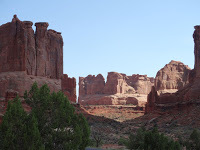 Abbey Country, July 2016. Photo: S. Jacques Stratton
Abbey Country, July 2016. Photo: S. Jacques Stratton
A compelling element of Desert Solitaire is the way the landscape serves a dual role, providing both springboard for Abbey's philosophical musings and emerging as one of the book's principal characters. Since the idea of nature as both setting and character helped guide the crafting of my own travel memoir, I readily recognize the motif in the work of others--though I admit Abbey takes it to a more polished and poetic level than I accomplish in Islands on the Fringe.
If desert splendor provides Abbey's primary muse, the BLM policy (in particular its plan to usher in a new era of industrial tourism) provides the primary antagonist, threatening to bring roads, dams, and the internal combustion (to Abbey, the "infernal combustion") engine into the sublime wonder of the canyonlands. Sadly, Abbey's vision of doom proved prescient; the Glen Canyon grottoes Abbey once marveled at now lie underwater, buried by Lake Powell and its attendant houseboat flotillas. Much like Abbey's poetic prose, Abbey's lamentations for lost nature resonate with me, and pique my nostalgia for once-empty waves now trammeled by commercial surf tourism. Of course, two decades into the 21st century, an uncritical sentimentalism for "the way it was" ranks among the most cliched forms of nostalgia. But consider that as recently as the eve of the millennium, one could spend a season surfing a wave now regarded as the world's best right and share it with only one or two others (I know because I lived it). Or consider that as recently as ten years ago, the perfect reefs of Blue Lagoon in Norther Luzon spun their typhoon swell magic for only a handful of seekers. It took only the dollar dreams of a Filipino and his government connection to bring, in just a few short years, a post-apocalyptic vision of tourist hell to the once-sleepy coves.
 One Filipino's vision of "development." Blue Lagoon, Northern Luzon in 2019. Photo: S. Jacques Stratton
One Filipino's vision of "development." Blue Lagoon, Northern Luzon in 2019. Photo: S. Jacques Stratton Thankfully, I know a few places that, like the more isolated corners of Abbey's canyonlands, still offer the consolation of nature. It's still a big ocean for the surf traveler. . .for now.
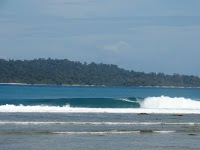 Sumatra Solitaire, July 2014. To the money-minded, that's some prime beachfront real estate. . .Photo : S. Jacques Stratton
Sumatra Solitaire, July 2014. To the money-minded, that's some prime beachfront real estate. . .Photo : S. Jacques StrattonBook Blurb: In Praise of Edward Abbery's Desert Solitaire

I first read Desert Solitaire as a college student. Bored with my term paper on the thematic concerns of the Victorian poets (memo to Matthew Arnold: it couldn't hurt to do some partying every now and then!), I longed for spring break and the possibility of libertine landscapes. The front cover of Desert Solitaire, with its wild canyonland panorama, caught my eye. Turning the pages, I found myself engrossed in a narrative that appealed to my incipient literary ambitions. Because of course English majors fancy themselves as writers, I thought that I could begin my own career in a fashion similar to Abbey--work for the BLM, live in a cabin, and write about adventures with my off-the-grid acquaintances. Like a heat mirage shimmering on a desert road, the idea dissipated when subjected to close scrutiny. Did I really want to uproot my L.A. life for the dust and loneliness of desert mesas? I had a band, I had a girlfriend, I had the beach with its delicious prospect of summertime south swells. The stings on our hearts. . .
Now, over two decades later, I find myself once again enchanted by the scenes, sentiments, and descriptions which Abbey brands with poetic fire upon the page. A Whitman of the desert, Abbey presents a narrative that calls to the soul like a barbaric yop echoing through the canyon of the Colorado. Consider the following imagistic indulgence:
"We shove our boats once again into the water, climb aboard and paddle slowly out of the Escalante's womb, back to the greater world of Glen canyon. . .Keeping to the shady side, we drift down the splendid river, deeper and deeper in to the fantastic. The sandstone walls rise higher than ever before, a thousand, two thousand feet above the water, rounding off on top as half domes and capitols, golden and glowing in the sunlight, a deep radiant red in the shade. . .beyond these mighty forms we catch occasional glimpses of eroded remnant--tapering spires, balanced rocks on pillars, mushroom rocks,, rocks like piles of melted pies. . .arches, grottoes, all the infinite variety of hill and hole and hollow to which sandstone lends itself. . ."
 Abbey Country, July 2016. Photo: S. Jacques Stratton
Abbey Country, July 2016. Photo: S. Jacques Stratton
A compelling element of Desert Solitaire is the way the landscape serves a dual role, providing both springboard for Abbey's philosophical musings and emerging as one of the book's principal characters. Since the idea of nature as both setting and character helped guide the crafting of my own travel memoir, I readily recognize the motif in the work of others--though I admit Abbey takes it to a more polished and poetic level than I accomplish in Islands on the Fringe.
If desert splendor provides Abbey's primary muse, the BLM policy (in particular its plan to usher in a new era of industrial tourism) provides the primary antagonist, threatening to bring roads, dams, and the internal combustion (to Abbey, the "infernal combustion") engine into the sublime wonder of the canyonlands. Sadly, Abbey's vision of doom proved prescient; the Glen Canyon grottoes Abbey once marveled at now lie underwater, buried by Lake Powell and its attendant houseboat flotillas. Much like Abbey's poetic prose, Abbey's lamentations for lost nature resonate with me, and pique my nostalgia for once-empty waves now trammeled by commercial surf tourism. Of course, two decades into the 21st century, an uncritical sentimentalism for "the way it was" ranks among the most cliched forms of nostalgia. But consider that as recently as the eve of the millennium, one could spend a season surfing a wave now regarded as the world's best right and share it with only one or two others (I know because I lived it). Or consider that as recently as ten years ago, the perfect reefs of Blue Lagoon in Norther Luzon spun their typhoon swell magic for only a handful of seekers. It took only the dollar dreams of a Filipino and his government connection to bring, in just a few short years, a post-apocalyptic vision of tourist hell to the once-sleepy coves.
 One Filipino's vision of "development." Blue Lagoon, Northern Luzon in 2019. Photo: S. Jacques Stratton
One Filipino's vision of "development." Blue Lagoon, Northern Luzon in 2019. Photo: S. Jacques Stratton Thankfully, I know a few places that, like the more isolated corners of Abbey's canyonlands, still offer the consolation of nature. It's still a big ocean for the surf traveler. . .for now.
 Sumatra Solitaire, July 2014. To the money-minded, that's some prime beachfront real estate. . .Photo : S. Jacques Stratton
Sumatra Solitaire, July 2014. To the money-minded, that's some prime beachfront real estate. . .Photo : S. Jacques Stratton


